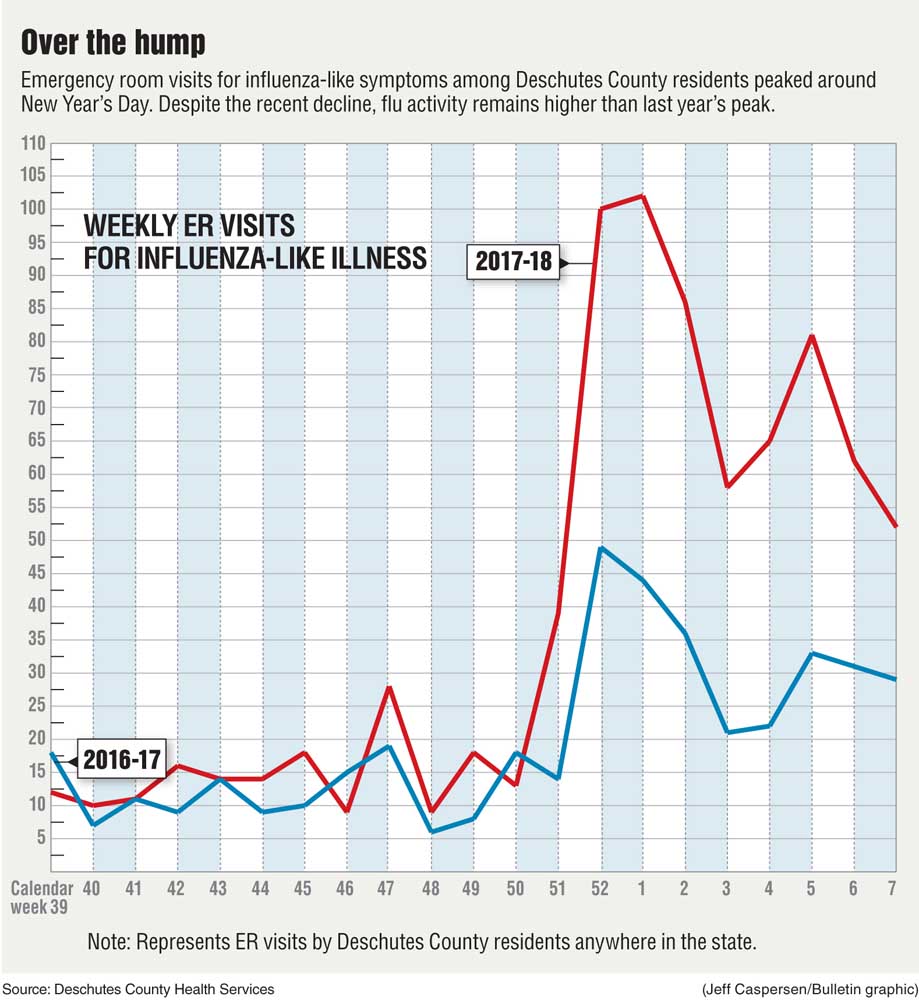Central Oregon flu season waning, but still strong
Published 12:00 am Saturday, February 24, 2018

- Central Oregon flu season waning, but still strong
The flu season appears to have peaked in Central Oregon, although activity remains higher than in past years.
The percentage of positive flu tests in Deschutes County dropped to 13 percent for the week ending Feb. 17, down from 18 percent in the previous two weeks. Emergency room visits for flu-like symptoms are down from a high of 100 to 102 cases in a week about the start of the new year, to 52 in a week by mid-February. That’s still higher than the 49 cases at the peak of the 2016-17 flu season.
“For the most part, we’re seeing a lot of good news,” said Jenny Faith, an epidemiologist with the Deschutes County Health Services. “It does look like, optimistically, we’ve peaked in January.”
Historically, the Central Oregon flu season reaches its peak in January or February, but for the past two years, the region has been hit hardest around the winter holiday break, she said. That could be linked to holiday travel, although transmission rates generally drop when children are out of school and fewer workers come into the office.
In the week between Christmas Eve and New Year’s, the number of patients testing positive for the flu at St. Charles Bend jumped to 95, compared to just 59 in the previous week. This week, the number of positive tests dropped down to 23.
“It’s definitely slowed down,” said Michelle Brenholdt, the hospital’s director of emergency services. “We’re seeing both our census slow down and our acuity.”
The hospital typically admits about 21 percent to 22 percent of patients that come to the emergency room, but at the height of the flu season, the admission rate jumped to 28 percent.
“The hospital was pretty full,” Brenholdt said. “So that kind of backed us up, because we couldn’t get patients upstairs, and the hospital was full because they couldn’t get their patients out.”
The admission rate has dropped to about 23 percent, slightly higher than normal.
The hospital is seeing an uptick in patients with respiratory syncytial virus, another sign that the flu season is slowing down.
“Generally, when we see flu peaks, we don’t see RSV. Flu becomes the predominant virus,” Brenholdt said. “As flu starts to wane, RSV can kind of get a hold, and it becomes more predominant.”
Nationwide, the flu season has been one of the worst in recent years, matching the levels seen during the 2009-10 season when the spread of the H1N1 virus reached pandemic levels. Officials from the Centers for Disease Control and Prevention reported Friday that at least 97 children have died from the flu this winter, and that 75 out of every 100,000 people have been hospitalized with the flu this season.
But CDC data also suggested that the flu season may have crested nationally, with the percentage of patients visiting doctors for flu-like symptoms dropping to 6.4 percent for the week ending Feb. 17, down from 7.5 percent in the previous week.
Oregon has seen slightly less flu transmission than the rest of the country, reporting only regional activity, while every other state except Hawaii is reporting widespread transmission.
State data suggests a leveling off from early January highs, with the percentage of positive flu tests dropping to 18 percent for the week ending Feb. 10, compared with 21 percent in the previous week.
But public health officials stress that flu is unpredictable and transmission is at historically high levels. And in some years, flu can spike twice.
‘We’re still seeing flu in the community,” Faith said, “and if you’re not vaccinated, it’s not too late.”
— Reporter: 541-633-2162, mhawryluk@bendbulletin.com








